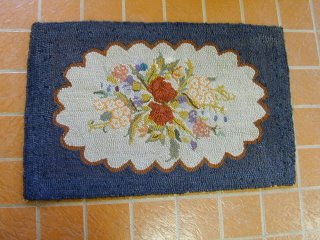
Old hooked rugs can be used as folk art, and - compared to antiques oil paintings and watercolors - are quite reasonable in price. One can regularly find very colorful and attractive vintage hooked rugs in the $200-450 range, often custom framed and ready to hang.
They can be quite delicate, since so many vintage rugs are 50 - 100 years old. These old textiles need to be cared for so you can enjoy your investment for many years to come.
Rugs can be cleaned and mounted on a frame. If you are well-versed in cleaning antique textiles, you can do it yourself. There are plenty of instructions on the Internet which will guide you through the process. However, because colors bleed easily in an old rug, you don't want to chance ruining it. That's where a professional rug restorer can save the day. If you need help finding a solid, experienced professional in this line of work, please contact me for a good reference.
In the meantime, here are some ideas on how to keep your rug in good shape:
- Simple cleaning - You can vacuum your rug with a vaccuum which has a hose attachment. Just put an old nylon stocking over the end of the nozzle before vacuuming the rug, so the suction doesn't pull any of the strips or yarns loose. Be sure to vaccuum both sides, since so much dust and dirt get buried in a rug's foundation. You can also use a window screen placed on the rug, then vacuum. Another possibility is to use a very soft brush - some of those old horse hair brushes are wonderful for this use - to brush away surface dirt.
- Safety on the floor - Never apply any kind of latex or rubber to the back of your vintage rug. This can ruin your rug, and certainly will affect it's value negatively. Instead, buy a rubber rug mat, made especially for stopping rugs from slipping when walked upon. These mats can be found at K-Mart, Walmart, and similar stores, don't cost much, and can easily be cut to size. Just lay this non-slip mat on the floor and place your rug over it - no need to attach it to the rug. This mat also traps dust and dirt particles, keeping your rug healthier by preventing friction against the floor, which might cause damage.
- Display - Some rugs are meant to be hung and enjoyed as wall art. If it's an unusual unique design, or if it's delicate, consider professionally mounting it. A restorer will know the proper method to mount your rug to prevent sagging and damage.
- Damaged Rugs - Just because a rug is damaged doesn't mean it can't be salvaged. If the rug "speaks" to you and the price is appropriate to the damage, consider buying it and having it restored. You won't regret it.
- Storage - If you need to store your rug, roll it up along the short edge with the top facing outwards. Put it in an old, clean pillowcase or sheet. Do not store it in plastic, as moisture can be trapped inside and cause serious damage to an old textile (this applies to other textiles too - like quilts, comforters, tablecloths, bedspreads, etc.).










No comments:
Post a Comment